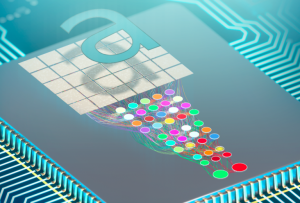
To speed up the abilities of processing, analyzing, storing and classifying images by computer chips, engineers at Penn have created a novel scalable chip which classifies and recognizes images almost instantaneously. The team— consisting of Firooz Aflatouni, Associate Professor in Electrical and Systems Engineering; Farshid Ashtiani, Postdoctoral Fellow; and Alexander J. Geers, graduate student— got rid of the principal time-consuming components in the traditional computer chip. These components are a large memory module, clock-based computations, the conversion of optical to electrical signals, and the need to convert the input data to binary format.
They achieved this through direct processing of the light received from the object of interest making use of an optical deep neural network executed on a 9.3 square millimeter chip.
The study described how the chip’s numerous optical neurons are connected using ‘waveguides’ to create a deep network of many ‘neuron layers’, similar to that of the human brain. Information goes through each layer of the network, and each step helps in classifying the input image into one of its categories.
Like in our brains, the deep network is designed in such a way that enables rapid information processing. The team demonstrated that the chip can perform the whole image classification process in half of a nanosecond.
‘Our chip processes information through what we call “computation-by-propagation”, meaning that unlike clock-based systems, computations occur as light propagates through the chip’, said Aflatouni. ‘We are also skipping the step of converting optical signals to electrical signals because our chip can read and process optical signals directly, and both of these changes make our chip a significantly faster technology.’
The chip’s ability to process optical signals directly leads directly to another benefit.
‘When current computer chips process electrical signals, they often run them through a Graphics Processing Unit, or GPU, which takes up space and energy,’ said Ashtiani. ‘Our chip does not need to store the information, eliminating the need for a large memory unit.’
‘And, by eliminating the memory unit that stores images, we are also increasing data privacy,’ said Alfatouni. ‘With chips that read image data directly, there is no need for photo storage and thus, a data leak does not occur.’
‘We aren’t the first to come up with technology that reads optical signals directly,’ said Geers, ‘but we are the first to create the complete system within a chip that is both compatible with existing technology and scalable to work with more complex data.’
The chip needs training to learn and classify new datasets, like how humans learn. The training needs to be one that results in accurate image classifications, and still be useful when presented with new datasets. The engineers can ‘scale up’ the deep network by including more neural layers, which would allow the chip to read data in more complicated images with higher resolution.
‘What’s really interesting about this technology is that it can do so much more than classify images,’ said Aflatouni. ‘We already know how to convert many data types into the electrical domain— images, audio, speech, and many other data types. Now, we can convert different data types into the optical domain and have them processed almost instantaneously using this technology.’
‘To understand just how fast this chip can process information, think of a typical frame rate for movies,’ he continued. ‘A movie usually plays between 24 and 120 frames per second, this chip will be able to process nearly 2 billion frames per second. For problems that require light speed computations, we now have a solution, but many of the applications may not be fathomable right now.’
Aflatouni’s current and future plans for this research aims to understand its abilities and limitations at more basic levels.
‘Our next steps in this research will examine the scalability of the chip as well as work on three-dimensional object classification,’ said Aflatouni. ‘Then maybe we will venture into the realm of classifying non-optical data. While image classification is one of the first areas of research for this chip, I am excited to see how it will be used, perhaps together with digital platforms, to accelerate different types of computations.’
By Marvellous Iwendi.
Source: Penn Engineering Today